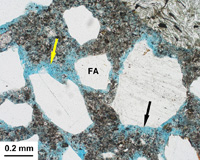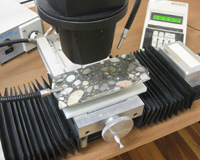


A hand-lapped concrete core section is placed on a semi-automated cross slide table designed to move the slab at 0.05” increments in both the X and Y direction. The entire assembly is positioned under a stereoscopic microscope. The assembly is used to perform air-void analysis in accordance with ASTM C 457. However, the method is also useful for quantifying the volume proportions of all concrete components for large-sized samples. These data are combined with petrography and cement content analysis in order to assist in reverse engineering of mix designs.

Cracking in concrete is not always a cause for alarm but root causes may not always be obvious during a visual survey. An adaptive reuse was planned for a sixty-year old structure but concerns were raised due to open cracks in structural concrete. Petrographic examination indicated that the proportion of fine aggregate (FA) was too low. The arrows in the photomicrograph illustrate porous bleed water channels that meander through the cement paste due to the low aggregate content. Along with a somewhat high water to cement ratio, the concrete was susceptible to shrinkage cracking. In this case, we determined that all cracks were dormant quelling fears of difficult to mitigate problems such as alkali-aggregate reaction.
Existing Condition Surveys
Testing requested for an existing condition survey commonly includes petrographic examination (ASTM C 856), air-void analysis (ASTM C 457), cement content analysis (ASTM C 1084), and/or chloride ion content (ASTM C 1218 or C 1152).
